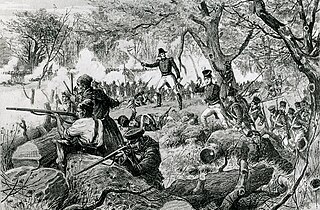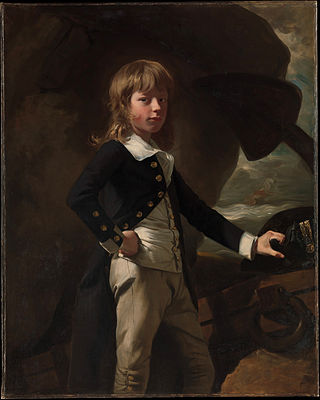
The War of 1812 was fought by the United States and its indigenous allies against the United Kingdom and its own indigenous allies in British North America, with limited participation by Spain in Florida. It began when the United States declared war on 18 June 1812. Although peace terms were agreed upon in the December 1814 Treaty of Ghent, the war did not officially end until the peace treaty was ratified by Congress on 17 February 1815.

The Confederate States Marine Corps (CSMC), also referred to as the Confederate States Marines, was a branch of the Confederate Navy during the American Civil War. It was established by an act of the Provisional Congress of the Confederate States on March 16, 1861. The Corps' manpower was initially authorized at 45 officers and 944 enlisted men, and was increased on September 24, 1862, to 1,026 enlisted men. The organization of the Corps began at Montgomery, Alabama, and was completed at Richmond, Virginia, when the capital of the Confederate States was moved to that location. The headquarters and main training facilities remained in Richmond throughout the war, located at Camp Beall on Drewry's Bluff and at the Gosport Shipyard in Portsmouth, Virginia. The last Marine unit surrendered to the Union army on April 9, 1865, with the Confederacy itself capitulating a month later.

The Second Battle of Sacket's Harbor, or simply the Battle of Sacket's Harbor, took place on 29 May 1813, during the War of 1812. A British force was transported across Lake Ontario and attempted to capture the town, which was the principal dockyard and base for the American naval squadron on the lake. Twelve warships were built here. The British were repulsed by American regulars, militia, marines and sailors.

The Royal Newfoundland Regiment is a Primary Reserve infantry regiment of the Canadian Army. It is part of the 5th Canadian Division's 37 Canadian Brigade Group.
The Sea Fencibles were naval fencible units established to provide a close-in line of defence and obstruct the operation of enemy shipping, principally during the French Revolutionary and Napoleonic Wars.

The Canadian Voltigeurs were a light infantry unit, raised in Lower Canada in 1812, that fought in the War of 1812 between Britain and the United States.

The Battle of Mackinac Island was a British victory in the War of 1812. Before the war, Fort Mackinac had been an important American trading post in the straits between Lake Michigan and Lake Huron. It was important for its influence and control over the Native American tribes in the area, which was sometimes referred to in historical documents as "Michilimackinac".

When the United States and the United Kingdom went to war against each other in 1812, the major land theatres of war were Upper Canada, Michigan Territory, Lower Canada and the Maritime Provinces of Nova Scotia, New Brunswick, Prince Edward Island and Cape Breton . Each of the separate British administrations formed regular and fencible units, and both full-time and part-time militia units, many of which played a major part in the fighting over the two and a half years of the war.

The Bermuda Volunteer Rifle Corps (BVRC) was created in 1894 as a reserve for the Regular Army infantry component of the Bermuda Garrison. Renamed the Bermuda Rifles in 1951, it was amalgamated into the Bermuda Regiment in 1965.

The Royal Garrison Artillery (RGA) was formed in 1899 as a distinct arm of the British Army's Royal Regiment of Artillery serving alongside the other two arms of the Regiment, the Royal Field Artillery (RFA) and the Royal Horse Artillery (RHA). The RGA were the 'technical' branch of the Royal Artillery who were responsible for much of the professionalisation of technical gunnery that was to occur during the First World War. It was originally established to man the guns of the British Empire's forts and fortresses, including coastal artillery batteries, the heavy gun batteries attached to each infantry division and the guns of the siege artillery. The RGA was amalgamated with the RFA in 1924, from which time the only two arms within the Royal Regiment of Artillery have been the Royal Artillery and the Royal Horse Artillery.
The Fencibles were British regiments raised in the United Kingdom, Isle of Man and in the colonies for defence against the threat of invasion during the Seven Years' War, the American War of Independence, the French Revolutionary Wars, the Napoleonic Wars and the War of 1812 in the late 18th and early 19th centuries. Usually temporary units, composed of local recruits and commanded by Regular Army officers, they were usually confined to garrison and patrol duties, freeing Regular Army units to perform offensive operations. Most fencible regiments had no liability for overseas service.

HMS Manly was a 12-gun Bold-class gun-brig of the Royal Navy, launched in 1812. She served in the War of 1812, her boats participating in the Battle of Lake Borgne. She was sold in 1833.
The Glengarry Light Infantry Fencibles were a light infantry unit, raised chiefly in the Glengarry District of Upper Canada shortly before the outbreak of the Anglo-American War of 1812. The unit fought throughout the war, and was disbanded shortly afterwards.
Captain Runchey's Company of Coloured Men was a Canadian militia company of free blacks and indentured black servants, raised in Upper Canada as a small Black corps under a White officer, Robert Reuben Runchey (1759–1819), a tavern keeper from Jordan, Upper Canada. The unit fought in several actions during the early part of the Anglo-American War of 1812. In 1813, Runchey's Company was converted into a unit of the Canadian Corps of Provincial Artificers, attached to the Royal Sappers and Miners, in which sappers and miners performed specialized military operations. They served on the Niagara River front during the war, and were disbanded a few months after the war ended. The Company of Coloured Men's military heritage is perpetuated in the modern Canadian Army by the Lincoln and Welland Regiment.

The Bermuda Garrison was the military establishment maintained on the British Overseas Territory and Imperial fortress of Bermuda by the regular British Army and its local militia and voluntary reserves from 1701 to 1957. The garrison evolved from an independent company, to a company of Royal Garrison Battalion during the American War of Independence, and a steadily growing and diversifying force of artillery and infantry with various supporting corps from the French Revolution onwards. During the American War of Independence, the garrison in Bermuda fell under the military Commander-in-Chief of America. Subsequently, it was part of the Nova Scotia Command until 1868, and was an independent Bermuda Command from then until its closure in 1957.

Augustus Brine was an officer of the Royal Navy who served during the American War of Independence and the French Revolutionary and Napoleonic Wars.
The Militia and Volunteers of County Durham are those military units raised in the County independent of the regular Army. The "modern" militia dates from legislation enacted during the Seven Years' War. The volunteers had several forms and separate periods of existence until made a permanent body in 1859.

The Corps of Invalids was a British unit that provided garrison troops for the defence of England and Great Britain between 1688 and 1802. The men and officers were all veterans of the British Army chosen by the commissioners of the Royal Hospital Chelsea to serve in lieu of a place at the hospital or receipt of a pension. The corps was rapidly expanded or decreased in size as needs arose and played a key role in regulating the manpower requirements of the British Army. The corps was organised into a number of independent companies that were garrisoned at key points in the country, freeing up units of the regular army for service overseas. The men were generally those who were too old or wounded to serve in the regular forces and most served at least six years with the corps. In the early years they wore a grey uniform but later wore the same red coat with blue facings as worn by the patients of the Chelsea Hospital.
104th Regiment of Foot was a regiment of the British Army. The regiment had its origins in the New Brunswick Regiment of Fencible Infantry, a unit of fencibles raised for the defence of the colony of New Brunswick in 1803. Recruits were drawn from across British North America, Scotland, Ireland and existing British Army units. The regiment was formally entered into the establishment in 1806 with a strength of around 650 enlisted men but grew to almost 1,100 by 1808. In 1810 the regiment's officers requested that it join the British Army as a regiment of foot. This request was granted on 13 September 1810 and the unit was renamed the 104th Regiment of Foot.












